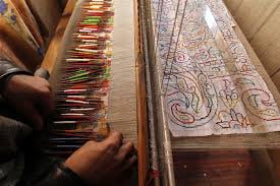
What are Pashmina Shawls made of?
Share
Introduction
Elegance draped in luxury – that's the epitome of a Pashmina shawl. These exquisite pieces are cherished worldwide for their unparalleled softness, warmth, and finesse. But what makes Pashmina shawls so exceptional? Let's delve even deeper into the intricate world of Pashmina and explore what these prized possessions are made of, unraveling the craftsmanship behind these masterpieces.
Understanding the Origin of Pashmina
Himalayan Origins: The Story Behind Pashmina
Pashmina wool finds its roots nestled in the high altitudes of the Himalayas. Derived from the underbelly fleece of the Changthangi goat, indigenous to the cold terrains of Nepal, India, and the Tibetan Plateau, this wool is renowned for its exceptional quality and scarcity. These goats endure harsh climates, developing an incredibly soft, fine inner coat to shield themselves from the extreme cold, which is the source of the coveted Pashmina fiber.
The Fine Art of Harvesting Pashmina
The process of collecting Pashmina involves utmost care and precision. Each spring, the Changthangi goats shed their winter coats naturally. Skilled herders carefully gather this fleece by combing or gently shearing the goats to obtain the fine, soft wool, a task that requires both patience and expertise.

Deciphering the Composition of Pashmina Shawls
Pashmina vs. Cashmere: Unraveling the Distinction
Pashmina and Cashmere are terms often used interchangeably, but there exists a nuanced difference. Cashmere is a broader term encompassing wool obtained from various breeds of cashmere goats around the world, while Pashmina refers specifically to the wool derived from the Changthangi goats in the Himalayan region. Pashmina, known for its finer texture and superior quality, is highly sought after for crafting luxurious shawls.
also read:- a detailed blog on machine vs hand made pashmina shawls
The Ethereal Pashmina Fiber
Pashmina fibers are incredibly delicate, measuring a mere 12-21 microns in diameter, which is why they are cherished for their unmatched softness. These ultra-fine fibers contribute to the lightweight yet remarkably warm nature of Pashmina shawls, making them a perfect accessory for any season.

Crafting the Pashmina Shawls
The creation of Pashmina shawls involves a blend of tradition, skill, and intricate craftsmanship. Expert artisans meticulously hand-spin and weave the delicate Pashmina fibers, often incorporating traditional techniques passed down through generations. The resulting shawls boast exquisite designs, intricate embroidery, and a luxurious feel, making each piece a unique work of art.

also read:- a detailed blog on crafting a shibori pashmina shawl
Pashmina Shawls: A Testament to Timeless Luxury
Embracing Sustainability: The Ethical Aspect of Pashmina Production
The sustainable and eco-friendly nature of Pashmina production is another facet that adds to its allure. The harvesting process does not harm the goats as the wool is collected during their natural shedding cycle. Moreover, the traditional methods employed in crafting Pashmina shawls often involve minimal impact on the environment, aligning with the principles of sustainability.

The Enduring Appeal of Pashmina Shawls
Pashmina shawls transcend fashion trends; they are timeless pieces that exude sophistication and elegance. Whether worn as a wrap for formal occasions or casually draped over shoulders, these shawls complement various outfits, adding a touch of luxury to any ensemble.
Conclusion
Pashmina shawls stand as a testament to the perfect amalgamation of nature's finest fibers and skilled craftsmanship. Their ethereal softness, warmth, and timeless appeal make them a coveted accessory worldwide. Understanding the intricate origins and meticulous process involved in creating Pashmina shawls adds depth to our appreciation for these luxurious pieces. As we embrace sustainability and timeless elegance, Pashmina shawls continue to reign as cherished symbols of sophistication and refinement
click the link to visit our website :- https://www.pashwrap.com/




